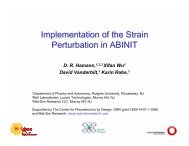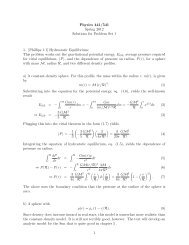Measurement of the Charged Pion Form Factor at EIC - Garth Huber
Measurement of the Charged Pion Form Factor at EIC - Garth Huber
Measurement of the Charged Pion Form Factor at EIC - Garth Huber
You also want an ePaper? Increase the reach of your titles
YUMPU automatically turns print PDFs into web optimized ePapers that Google loves.
<strong>Measurement</strong> <strong>of</strong> <strong>the</strong> <strong>Charged</strong> <strong>Pion</strong><br />
<strong>Form</strong> <strong>Factor</strong> <strong>at</strong> <strong>EIC</strong><br />
<strong>Garth</strong> <strong>Huber</strong> and Dave Gaskell<br />
(U. Regina and JLab)<br />
Electron-Ion Collider Workshop:<br />
Electron Nucleon Exclusive Reactions<br />
March 14, 2010
pQCD and <strong>the</strong> <strong>Pion</strong> <strong>Form</strong> <strong>Factor</strong><br />
F π<br />
(Q 2 ) = 4 3 πα s<br />
dxdy 2<br />
0<br />
3<br />
∫<br />
1<br />
1<br />
φ(x)φ(y)<br />
xyQ 2<br />
€<br />
φ π<br />
(x)<br />
→ 3 f π<br />
x(1− x)<br />
Q 2 →∞ n c<br />
φ π<br />
€<br />
F π<br />
(Q 2 )<br />
→ 16πα s (Q2 2<br />
) f π<br />
Q 2 →∞ Q 2
<strong>Measurement</strong> <strong>of</strong> π + <strong>Form</strong> <strong>Factor</strong> – Low Q 2<br />
• At low Q 2 , F π can be measured directly via high<br />
energy elastic π sc<strong>at</strong>tering from <strong>at</strong>omic electrons<br />
– CERN SPS used 300 GeV pions to measure form<br />
factor up to Q 2 = 0.25 GeV 2<br />
[Amendolia et al, NPB277, 168 (1986)]<br />
– These d<strong>at</strong>a used to extract <strong>the</strong> pion charge radius<br />
r π = 0.657 ± 0.012 fm<br />
• Maximum accessible Q 2<br />
roughly proportional to pion<br />
beam energy<br />
– Q 2 =1 GeV 2 requires<br />
1000 GeV pion beam
<strong>Measurement</strong> <strong>of</strong> π + <strong>Form</strong> <strong>Factor</strong> – Larger Q 2<br />
• At larger Q 2 , F π must be measured indirectly using <strong>the</strong><br />
“pion cloud” <strong>of</strong> <strong>the</strong> proton via p(e,e’π + )n<br />
– At small –t, <strong>the</strong> pion pole process domin<strong>at</strong>es <strong>the</strong><br />
longitudinal cross section, σ L<br />
– In Born term model, F π<br />
2<br />
appears as,<br />
• Drawbacks <strong>of</strong> <strong>the</strong> this technique<br />
– Isol<strong>at</strong>ing σ L experimentally<br />
challenging<br />
– Theoretical uncertainty in<br />
form factor extraction
F π Extraction from JLab d<strong>at</strong>a<br />
VGL Regge Model<br />
Horn et al, PRL97, 192001,2006<br />
• Feynman propag<strong>at</strong>or replaced by π<br />
and ρ Regge propag<strong>at</strong>ors.<br />
– Represents <strong>the</strong> exchange <strong>of</strong> a<br />
series <strong>of</strong> particles, compared<br />
to a single particle.<br />
• Model parameters fixed from pion<br />
photoproduction.<br />
• Free parameters: Λ π , Λ ρ (trajectory<br />
cut<strong>of</strong>f) .
Unpolarized <strong>Pion</strong> Cross Section<br />
2π d2 σ<br />
dtdφ = ɛdσ L<br />
dt<br />
+ dσ T<br />
dt<br />
t = four-momentum transferred to<br />
nucleon<br />
= (mass) 2 <strong>of</strong> struck virtual pion<br />
W = total energy in virtual photontarget<br />
center <strong>of</strong> mass<br />
Q 2 = -(mass) 2 <strong>of</strong> virtual photon<br />
ε = virtual photon polariz<strong>at</strong>ion, 01<br />
φ = azimuthal angle between<br />
reaction plane and sc<strong>at</strong>tering plane<br />
+ √ 2ɛ(1 + ɛ) dσ LT<br />
dt<br />
cos φ + ɛ dσ TT<br />
dt<br />
cos 2φ<br />
L-T separ<strong>at</strong>ion required to extract σ L
L-T Separ<strong>at</strong>ion in an e-p Collider<br />
ε =<br />
2(1− y)<br />
1+ (1− y)<br />
2<br />
where <strong>the</strong> fractional energy loss y ≈<br />
Q2<br />
xs tot<br />
€
Sc<strong>at</strong>tered electron detection requirements
Recoil detector requirements
Kinem<strong>at</strong>ic Reach (<strong>Pion</strong> <strong>Form</strong> <strong>Factor</strong>)
Kinem<strong>at</strong>ic Reach (<strong>Pion</strong> <strong>Form</strong> <strong>Factor</strong>)<br />
Q 2 reach comparable to th<strong>at</strong> <strong>of</strong> recent γγπ 0 transition<br />
form factor measurements from Babar
F π Comp<strong>at</strong>ible with m<strong>EIC</strong>?<br />
solenoid<br />
detectors<br />
ion dipole w/ detectors<br />
(approxim<strong>at</strong>ely to scale)<br />
ion FFQs<br />
0°<br />
IP<br />
ions<br />
3°<br />
electron FFQs<br />
θ n >0.5 degrees<br />
electrons<br />
From m<strong>EIC</strong> parameters document:<br />
E e = 3-11 GeV (mostly ok)<br />
E p = 20-60 GeV (not ok for low ε <strong>at</strong> lowest Q 2 )<br />
θ n
F π Comp<strong>at</strong>ible with m<strong>EIC</strong>?<br />
solenoid<br />
detectors<br />
ion dipole w/ detectors<br />
(approxim<strong>at</strong>ely to scale)<br />
ion FFQs<br />
0°<br />
IP<br />
ions<br />
3°<br />
electron FFQs<br />
θ n >0.5 degrees<br />
electrons<br />
θ n
Extract σ L with no L-T separ<strong>at</strong>ion?<br />
In principle possible to extract R=σ L /σ T using polariz<strong>at</strong>ion degrees <strong>of</strong><br />
freedom<br />
In parallel kinem<strong>at</strong>ics<br />
(outgoing meson along ) ⃗q<br />
χ z =<br />
1<br />
P e<br />
√<br />
1 − ɛ<br />
2 P z<br />
R L<br />
R T<br />
= 1 ɛ<br />
( 1<br />
χ z<br />
− 1)<br />
χ z = z-component <strong>of</strong> proton<br />
“reduced” recoil polariz<strong>at</strong>ion in<br />
H(e,e’p)π 0<br />
Schmieden and Tit<strong>at</strong>or [Eur. Phys. J. A 8, 15-17 (2000)]<br />
A similar rel<strong>at</strong>ion holds for pion production from a polarized target if<br />
we re-define χ z<br />
χ z =<br />
1<br />
2P e P T<br />
√<br />
1 − ɛ<br />
2 A z<br />
A z = target doublespin<br />
asymmetry
Isol<strong>at</strong>ing σ L with Polariz<strong>at</strong>ion D.O.F<br />
σ pol ∼ P e P p<br />
√<br />
(1 − ɛ2 )A z<br />
Nominal, high energies, ε very close to 1.0 destroys<br />
figure <strong>of</strong> merit for this technique √<br />
If we can adjust ε to 0.9 <strong>the</strong>n (1 − ɛ2 ) → 0.44<br />
√<br />
ε= 0.95 (1 − ɛ2 ) → 0.31<br />
Example: At Q 2 = 5, lowest s <strong>of</strong> 3 GeV e- on 20 GeV p<br />
results in <strong>the</strong> smallest ε=0.947 (for which neutron is still<br />
easily detectable)<br />
Additional issue: A z = component <strong>of</strong> p polariz<strong>at</strong>ion parallel<br />
to q proton polariz<strong>at</strong>ion direction ideally tunable <strong>at</strong> IP
Parallel Kinem<strong>at</strong>ics<br />
Polariz<strong>at</strong>ion rel<strong>at</strong>ion for extracting σ L /σ T only applies in<br />
parallel kinem<strong>at</strong>ics – how quickly does this rel<strong>at</strong>ion break<br />
down away from θ CM = 0?<br />
MAID2007<br />
Q 2 =5 GeV2<br />
W = 1.95 GeV
L/T Extraction<br />
Extraction via this technique requires strict cuts on θ CM<br />
Q 2 =5 GeV 2 , (3 on 20):<br />
1 degree CM cut<br />
corresponds to ~ 30 mrad<br />
in <strong>the</strong> lab<br />
Q 2 =25 GeV 2 , (5 on 50):<br />
1 degree CM cut<br />
corresponds to 20 mrad<br />
in <strong>the</strong> lab<br />
At 1 degree, polariz<strong>at</strong>ion<br />
observable already ~ 15%<br />
different from true value<br />
very tight cuts will be<br />
needed (0.1 degrees?)
Summary<br />
• <strong>Measurement</strong> <strong>of</strong> F π <strong>at</strong> <strong>EIC</strong> will be challenging<br />
– Use <strong>of</strong> L-T separ<strong>at</strong>ion made easier with energies outside <strong>of</strong><br />
“nominal”<br />
– Reduction <strong>of</strong> neutron detection “dead zone” would also be<br />
beneficial<br />
– Extreme forward neutron detection ( 0.5 degrees phase space for this is quite<br />
small and –t pretty large (-t ~ 0.2)<br />
• <strong>Measurement</strong> using polariz<strong>at</strong>ion degrees <strong>of</strong> freedom seems, <strong>at</strong><br />
first glance, feasible not impossible<br />
– Very tight cuts on pion angle will be required<br />
– More detailed studies required a model incorpor<strong>at</strong>ing all<br />
response functions needed to simul<strong>at</strong>e how close to parallel<br />
we must be
Extra
F π +(Q 2 ) after JLAB 12 GeV Upgrade<br />
• JLab 12 GeV upgrade will<br />
allow measurement <strong>of</strong> F π up<br />
to 6 GeV 2<br />
– Will we see <strong>the</strong><br />
beginning <strong>of</strong> <strong>the</strong><br />
transition to <strong>the</strong><br />
perturb<strong>at</strong>ive regime?<br />
• Additional point <strong>at</strong> Q 2 =1.6<br />
GeV 2 will be closer to pole:<br />
will provide ano<strong>the</strong>r<br />
constraint on -t min<br />
dependence<br />
• Q 2 =0.3 GeV 2 point will be<br />
best direct test <strong>of</strong> agreement<br />
with elastic π+e d<strong>at</strong>a
Low ε F π Kinem<strong>at</strong>ics<br />
Q 2 P p P e -t ε θ n<br />
5 5 2 0.047 0.78 0.32<br />
6 5 3 0.031 0.80 0.19<br />
8 5 3 0.052 0.77 0.28<br />
10 5 4 0.042 0.75 0.19<br />
10 10 5 0.008 0.80 0.02<br />
12.5 5 4 0.062 0.72 0.26<br />
12.5 10 4 0.013 0.64 0.02<br />
15 5 4 0.085 0.69 0.32<br />
15 10 5 0.018 0.78 0.04<br />
15 15 6 0.006 0.79 0.01<br />
17.5 10 5 0.024 0.77 0.04<br />
17.5 15 6 0.008 0.78 0.01<br />
20 10 5 0.030 0.75 0.05<br />
20 15 6 0.010 0.77 0.01<br />
25 15 6 0.015 0.76 0.02


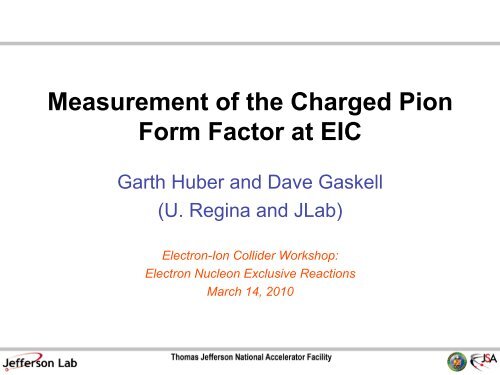
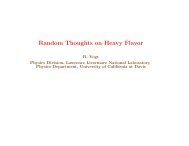

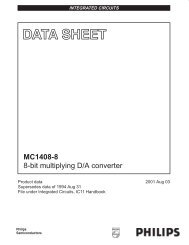

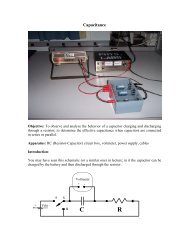


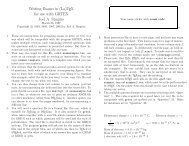
![More Effective C++ [Meyers96]](https://img.yumpu.com/25323611/1/184x260/more-effective-c-meyers96.jpg?quality=85)


